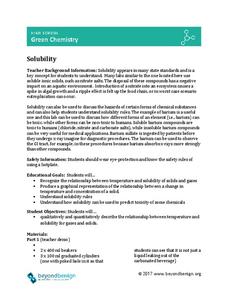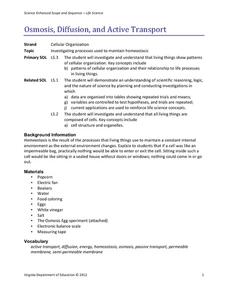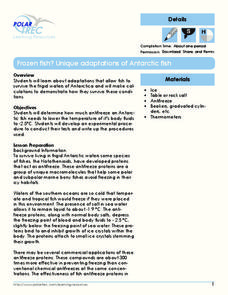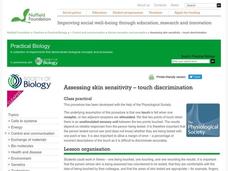National Park Service
Caves, Canyons, Cactus, and Critters
Mother Nature's Gravel Company is open for business! The unit includes four lessons covering weathering and erosion. Experiments are simple to complete and young geologists compare notes to see who makes the biggest ice wedge, moves...
Pingry School
Gas Pressure and Volume Relationship
Do your high school scientists know the four methods scientists use to communicate information? A simple experiment discovering the relationship between gas pressure and volume allows pupils to practice all four. After completing the...
Beyond Benign
Solubility
Enhance your class' ability to understand solubility. Science scholars examine how temperature and concentration affect solubility using an interesting lab experiment. The introduction and procedure also discuss the relationship between...
CK-12 Foundation
Horse and Cart
Can a horse pull more than its weight? A simple simulation answers this question and more. Pupils adjust the mass in a cart, the mass of the horse, the acceleration of the horse, and the angle of the tension rope between the horse and...
Virginia Department of Education
Osmosis, Diffusion, and Active Transport
No, it really is okay to play with your food! Emerging scientists manipulate popcorn, eggs, and other household objects as they demonstrate multiple cellular processes. The activity, capable of modifications, is designed to reflect the...
Mr. Hill's Science Website
Density Workbook
It's all about density! Here's a dense workbook for young scientists; they solve (and show work for) 29 density word problems, including a problem where they solve for the density of Godzilla. They complete labs analyzing metal cubes,...
Curated OER
Osmosis and Dialysis
How do you engage pupils in a discussion about osmosis without leaving them overwhelmed? By providing them with the tools to perform an exciting experiment, and they will see osmosis in action! Young chemists and biologists use a potato...
Curated OER
Experimenting with Pressure and Volume
Students explore the relationship between temperature and pressure using a paper-pencil laboratory activity and software. The nature and behavior or gases with respect to temperature is the focus of this lesson.
Herff Jones Education
Reaction Rates
Equip pupils with tools to determine reaction rates as they explore conditions that cause a reaction to increase or decrease. They also discuss why this occurs and predict the next steps as they take part in a series of experiments.
Polar Trec
Frozen Fish? Unique Adaptations of Antarctic Fish
Some fish contain proteins that act like antifreeze in order for them to live in the frigid waters of Antarctica! High schoolers determine how much antifreeze a fish needs to lower its body temp to -2.5 degrees. Teachers act as a...
Chemistry Collective
Virtual Lab: Determination of the pH Scale by the Method of Successive Dilutions
Where did the pH scale come from? Take a deeper look at a most important measure of ion concentration using a simulated physical determination. Young chemists prepare a series of dilutions after determining a dilution factor for the...
Nuffield Foundation
Assessing Skin Sensitivity—Touch Discrimination
How do we distinguish between the number of things touching our skin? Scholars explore an interesting lesson through an experiment. They learn that there must be an unstimulated sensory unit between two touches to distinguish them. They...
PBS
Seasons on Earth and Mars
Winter, spring, summer, and fall—Earth experiences them all! But what about Mars? Scholars compare the planets in terms of distance, tilt, and rotation during a lesson from PBS's Space series. Great visual models of Earth and Mars, plus...
Biology Junction
Dissection of the Clam
Is the structure of a clam really as simple as it seems? Young scholars explore the anatomy of the clam in an engaging lesson presentation. The lesson highlights the digestive process of the clam as well as how it moves and what it does...
Curated OER
Brown Bag Science
Students discover, through the discovery method, how electricity works. They construct a simple circuit and a parallel circuit, make an electrical motor work and add a switch to turn it on and off.
Curated OER
Simple Machines - Inclined Plane
Students learn the fundamentals and daily applications of simple machines.
Curated OER
Simple Machines
Young scholars engage in a instructional activity that explores the concept of simple machines. They view a powerpoint media presentation and then are introduced to adult volunteers for the instructional activity. Each volunteer is at a...
Alabama Learning Exchange
Simple Machines Internet Research
Young scholars identify six types of simple machines, then use the Internet for research.
Curated OER
Simple Machines
Learners investigate simple machines. In this simple machines lesson, students explore how tools increase productivity and make life easier. Learners experiment with simple tools and discover the parts of each tool.
Curated OER
Simple Machines in the Home
Students explore simple machines used in the home. In this simple machines lesson, students discover that many household items are constructed from simple machines. Students interact with nutcrackers, peelers, egg slicers, and egg beaters.
Curated OER
Challenger's Lost Lessons - The Lost Simple Machines Lesson
Students investigate the characteristics of simple machines. In this simple machine lesson, students investigate work as a product of applying constant force. They answer questions about what happens on Earth and what may have happened...
Curated OER
Simple Machines on the Move
Third graders explore simple machines. For this simple machine lesson students experiment with motion and force. Students have hands on activities and resources are provided.
Curated OER
Simple Machines-Pulleys
Third graders understand what a pulley is and how it works. In this simple machines, pulley lesson plan students experiment with broom sticks creating a pulley. Students observe how the pulley moves in its different trials.
Curated OER
Simple machine Webqest
Third graders explore simple machines. Using specified Internet sites, 3rd graders gather information on types of machines. They define vocabulary words and locate examples of different types of simple machines. Students invent a new...

























